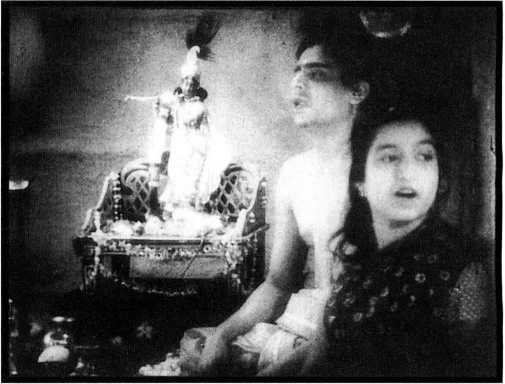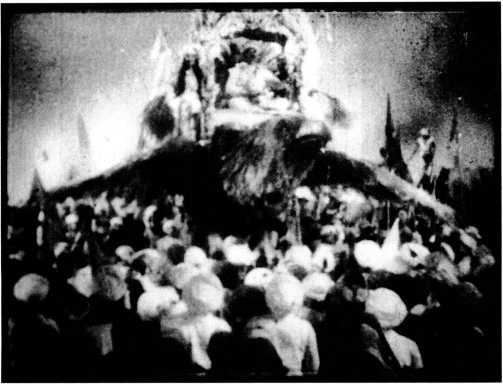In India, with twelve major languages and twenty secondary ones, the silent cinema was a widely accessible entertainment. The films took their plots from well-known tales in the epics Ramayana and Mahabarata and the images carried the burden of the story. Although intertitles were in as many as four languages, and sometimes a narrator akin to the Japanese benshi accompanied screenings, the Indian silent film found a national audience. Following the work of D. G. Phalke in the 1910s (p. 51), several production companies sprang up in Bombay and Calcutta. By the mid-1920s, India was producing over a hundred feature films annually, more than England, France, or the USSR.
Indian producers sought to imitate Hollywood’s studio system, but they could not achieve oligopolistic vertical integration. In an attempt to do so, Madan Theatres, the most powerful exhibition chain at the end of the 1920s, bought American sound equipment and built a studio in the Calcutta suburb of Tollygunge (soon known by the nickname “Tollywood”). It released the first Indian talking films in 1931, but problems of cash flow forced Madan to sell its studio and most of its theaters. Thereafter, the Indian market would be a free-for-aH in which production firms, distributors, and exhibitors vied for power.
The fragmentation of the market was increased by the coming of sound, which broke the national audience into language-based groups. Calcutta firms monopolized Bengali-language production, Bombay controlled production in Marathi, and both cities made films in Hindi, India’s principal language. Slowly some production emerged in Madras, specializing in southern languages.
At first, producers controlled the market. The earliest talking feature, the Imperial Film Company’s Alam Ara (“Beauty of the World,” 1931, Ardeshir Irani; Hindi language) proved a huge success, and other producers quickly converted to sound. The major firms were Prabhat, founded in 1929 and operating in a suburb of Bombay; New Theatres, founded in 1930 in Calcutta; and Bombay Talkies, founded in 1934. All were modeled on Hollywood studio complexes, with sound stages, laboratories, and commissaries. Although the producers sought to imitate Hollywood’s efficient planning and scheduling, they prided themselves on running friendly, “one-big-family” operations.

11.43 Chandidas: The low-caste woman sings with the holy man before his altar.
By the mid-1930s, film companies were turning out a total of about 200 films a year, most of them in Hindi. Although the number of theaters increased throughout the 1930s and 1940s, it did not keep pace with the expansion of production or the growing urban population. Exhibitors competed frantically to show the most popular movies. Production companies manipulated the theater owners through block booking.
Mythologicals, Socials, and Devotionals
The success of the Indian talking picture owed much to its musical sequences. Folk performance and Sanskrit theater were based on music, and these traditions found their way into the cinema. For decades, nearly all films, regardless of genre, contained song and dance interludes. An early and influential example is Chandidas (1932, Debahi Bose; Bengali; 11.43). It featured both songs and a continuous musical background in the manner of Hollywood underscoring. Initially, most stars sang their own parts, but, during the 1940s, firms began to use playback singers, who prerecorded the songs for the actors.
The genres of the 1930s had been established in the silent era. The mythological film, using a plot derived from legend and the literary epics, had been a mainstay since Phalke’s day. More westernized were the stunt films, adventure stories modeled on those starring Douglas Fairbanks and Pearl White. Most were cheap productions akin to Hollywood’s B pictures; those featuring the masked outlaw woman Nadia were especially popular.
The social film, a romantic melodrama set in contemporary times, was introduced in the mid-1920s and

11.44 The bird-chariot that carries the hero to heaven at the climax of Sant Tukaram.
Became an important genre in the sound era. One of the most famous socials was New Theatres’ Devdas (1935; Hindi), which used naturalistic dialogue to show the suffering of lovers torn apart by an arranged marriage. Other socials addressed contemporary problems of labor, the caste system, and sexual equality.
Another major genre was the devotional, a biographical tale of a religious figure. The most popular was Sant Tukaram (“Saint Tukaram,” 1936, Moham Sinha; Marathi), made by Prabhat. A poor villager who spends his days singing holy songs is persecuted by the corrupt Brahmin priest. Tukaram’s faith creates several miracles, and he is eventually taken to Nirvana in a heavenly chariot (11.44). The hero’s gentle personality, the understated performances, and the lyrical beauty of the songs, nearly all composed by the historical saint, led many critics to judge Saint Tukaram the masterpiece of 1930s Indian filmmaking.
Independents Weaken the System
By 1939, India’s film industry was apparently robust. Although the market was still dominated by foreign films, the rise of the talkie had greatly increased audiences for Indian cinema. India had become the third-largest film producer in the world, and Saint Tukaram won a prize at the Venice Film Festival. The mobilization for World War II improved the national economy.
The wartime boom also revealed, however, that the film industry was fundamentally unstable. In search of quick profits, entrepreneurs began to form independent production companies, and black marketers used film projects to launder cash. The independents lured stars, directors, and songwriters away from the studios, often paying bonuses in under-the-table deals. Now the older firms had to compete for personnel, and a star might consume half a film’s budget. The studios’ one-big-family ideology collapsed when stars and creative personnel realized their market value. Moreover, the independents did not have to maintain the massive overhead that encumbered the studios; a producer could simply rent studio space and hire personnel as needed. Now that more companies were offering more films, distributors and theater owners could make the studios compete for screens.
Their failure to achieve vertical integration proved fatal to the big companies. Prabhat, New Theatres, and Bombay Talkies continued to make films throughout the war, but their power ebbed. Only the government’s wartime restrictions on investment and raw film stock kept the transient “mushroom producers” from overrunning the market. Once the war was over, black-market profiteering ran unchecked. Although film production expanded and became even more significant internationally, India’s studio system was at an end.




 World History
World History



![The Battle of Britain [History of the Second World War 9]](/uploads/posts/2015-05/1432582012_1425485761_part-9.jpeg)





